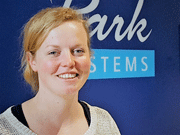Thursday, 3 September 2020
- 10:00 am – 11:30 am
(GMT)
London, Dublin - 11:00 am – 12:30 pm
(CEST)
Berlin, Paris, Rome - 18:00pm – 19:30 pm
[UTC+9]
Seoul, Tokyo -

With ever-decreasing device sizes in the semiconductor industry, the demand for functional materials with low dimensionality continues to grow. Since the discovery of graphene in 2004,1 2D materials have caught
the interest of scientific and industrial research. Among 2D materials for semiconductor applications, transition metal dichalcogenides (TMDs) are particularly promising. However, TMDs often exhibit morphological
features such as grain boundaries, which affect the electronic properties locally.2 Hence, characterization of TMDs requires techniques with high spatial resolution and sensitivity for electronic properties,
including conductivity and surface potential. Atomic Force Microscopy not only offers topography imaging with local resolutions on the nanoscale, but also resolves electronic properties by scanning the surface
with an electrically conductive tip.
In this webinar, we will demonstrate on Park’s NX Hivac how high vacuum (10-5 Torr) significantly improves the sensitivity and the resolution of electrical AFM modes on TMDs.
The removal of the surface water
layer leads to an improved electrical contact between tip and sample. At the same time, the vacuum environment prevents the adverse doping effect of the TMD material, which effectively lowers the material’s
conductivity. Thereby, the local electronic characterization of TMDs can be pushed to the next level.
1.Novoselov, K. S. et al. Electric Field Effect in Atomically Thin Carbon Films. Science (80-. ). 306, 666 LP – 669 (2004).
2.Ludwig, J. et al. Effects of buried grain boundaries in multilayer MoS2. Nanotechnology 30, 285705 (2019).

Presented By :
Ilka Hermes - Principle Scientist Park Systems Europe, Mannheim, Germany
ihermes@parksystems.com
Ilka is the principle scientist at Park Systems Europe, where she maintains and supports scientific collaborations to establish new research projects.
Prior, she worked at the Max Planck Institute for Polymer Research (Main Germany) in the group of Stefan Weber to investigate perovskite solar cells with electrical Atomic Force Microscopy (AFM) modes, and at the Johannes Gutenberg University Mainz in the group of Angelika Kühnle to characterize liquid-solid interfaces with high resolution AFM. Ilka’s primary fields of expertise include Piezoresponse Force Microscopy (PFM), Kelvin Probe Force Microscopy (KFM), and conductive AFM on semiconducting and/or ferroelectric devices.






